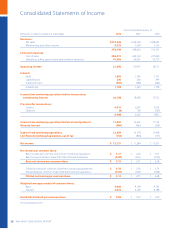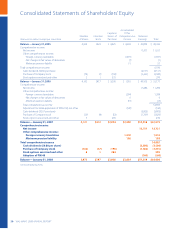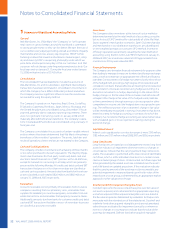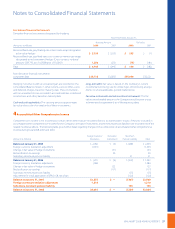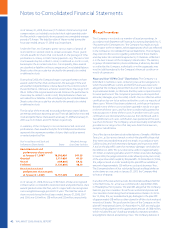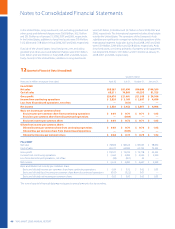Walmart 2008 Annual Report Download - page 38
Download and view the complete annual report
Please find page 38 of the 2008 Walmart annual report below. You can navigate through the pages in the report by either clicking on the pages listed below, or by using the keyword search tool below to find specific information within the annual report.
36 WAL-MART 2008 ANNUAL REPORT
Notes to Consolidated Financial Statements
Long-term debt is unsecured except for $1.1 billion, which is
collateralized by property with an aggregate carrying amount of
approximately $1.3 billion. Annual maturities of long-term debt
during the next ve years and thereafter are:
(Amounts in millions) Annual
Fiscal Year Maturity
2009 $ 5,913
2010 4,786
2011 3,002
2012 2,580
2013 592
Thereafter 18,839
Total $35,712
The Company has entered into sale/leaseback transactions involving
buildings while retaining title to the underlying land. These transac-
tions were accounted for as nancings and are included in long-term
debt and the annual maturities schedule above. The resulting obliga-
tions mature as follows during the next ve years and thereafter:
(Amounts in millions) Annual
Fiscal Year Maturity
2009 $ 10
2010 10
2011 10
2012 10
2013 10
Thereafter 290
Total $340
The Company had trade letters of credit outstanding totaling $2.7 billion
and $3.0 billion at January 31, 2008 and 2007, respectively. At January 31,
2008 and 2007, the Company had standby letters of credit outstand-
ing totaling $2.2 billion. These letters of credit were issued primarily
for the purchase of inventory and self-insurance purposes.
3 Financial Instruments
The Company uses derivative nancial instruments for hedging and
non-trading purposes to manage its exposure to changes in interest
and foreign exchange rates. Use of derivative nancial instruments
in hedging programs subjects the Company to certain risks, such as
market and credit risks. Market risk represents the possibility that the
value of the derivative instrument will change. In a hedging relation-
ship, the change in the value of the derivative is oset to a great extent
by the change in the value of the underlying hedged item. Credit risk
related to derivatives represents the possibility that the counterparty
will not fulll the terms of the contract. The notional, or contractual,
amount of the Company’s derivative nancial instruments is used
to measure interest to be paid or received and does not represent
the Company’s exposure due to credit risk. Credit risk is monitored
through established approval procedures, including setting concen-
tration limits by counterparty, reviewing credit ratings and requiring
collateral (generally cash) when appropriate. The majority of the
Company’s transactions are with counterparties rated “AA-” or better
by nationally recognized credit rating agencies.
Fair Value Instruments
The Company enters into interest rate swaps to minimize the risks and
costs associated with its nancing activities. Under the swap agree-
ments, the Company pays variable-rate interest and receives xed-rate
interest payments periodically over the life of the instruments. The
notional amounts are used to measure interest to be paid or received
and do not represent the exposure due to credit loss. All of the Com-
pany’s interest rate swaps that receive xed interest rate payments
and pay variable interest rate payments are designated as fair value
hedges. As the specic terms and notional amounts of the derivative
instruments match those of the instruments being hedged, the
derivative instruments were assumed to be perfectly eective hedges
and all changes in fair value of the hedges were recorded on the
balance sheet with no net impact on the income statement.
Net Investment Instruments
At January 31, 2008 and 2007, the Company is party to cross-currency
interest rate swaps that hedge its net investment in the United King-
dom. The agreements are contracts to exchange xed-rate payments
in one currency for xed-rate payments in another currency.
The Company has outstanding approximately £3.0 billion of debt that
is designated as a hedge of the Company’s net investment in the
United Kingdom as of January 31, 2008 and 2007. The Company also
has outstanding approximately ¥142.1 billion of debt that is designated
as a hedge of the Company’s net investment in Japan at January 31,
2008 and 2007. All changes in the fair value of these instruments are
recorded in accumulated other comprehensive income, osetting
the foreign currency translation adjustment that is also recorded in
accumulated other comprehensive income.
Cash Flow Instruments
The Company was party to a cross-currency interest rate swap to
hedge the foreign currency risk of certain foreign-denominated debt.
The swap was designated as a cash ow hedge of foreign currency
exchange risk. The agreement was a contract to exchange xed-rate
payments in one currency for xed-rate payments in another cur-
rency. Changes in the foreign currency spot exchange rate resulted
in reclassication of amounts from accumulated other comprehensive
income to earnings to oset transaction gains or losses on foreign-
denominated debt. The instruments matured in scal 2007.




